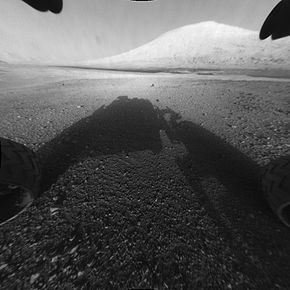 The rover Curiosity landed on August 6, 2012, near the base of Aeolis Mons. | |
| Location | Gale crater on Mars |
|---|---|
| Coordinates | 5°05′S 137°51′E / 5.08°S 137.85°E |
| Peak | Aeolis Mons – 5.5 km (3.4 mi) 18,045 ft (5,500 m)[1] |
| Discoverer | NASA in the 1970s |
| Eponym | Aeolis Mons – Aeolis albedo feature Mount Sharp – Robert P. Sharp (1911–2004) |
Mount Sharp, officially Aeolis Mons (/ˈiːəlɪs mɒnz/), is a mountain on Mars. It forms the central peak within Gale crater and is located around 5°05′S 137°51′E / 5.08°S 137.85°E, rising 5.5 km (18,000 ft) high from the valley floor. Its ID in the United States Geological Survey's Gazetteer of Planetary Nomenclature is 15000.[2]
On August 6, 2012, Curiosity (the Mars Science Laboratory rover) landed in "Yellowknife" Quad 51[3][4][5][6] of Aeolis Palus,[7] next to the mountain. NASA named the landing site Bradbury Landing on August 22, 2012.[8] Aeolis Mons is a primary goal for scientific study.[9] On June 5, 2013, NASA announced that Curiosity would begin an 8 km (5.0 mi) journey from the Glenelg area to the base of Aeolis Mons. On November 13, 2013, NASA announced that an entryway the rover would traverse on its way to Aeolis Mons was to be named "Murray Buttes", in honor of planetary scientist Bruce C. Murray (1931–2013).[10] The trip was expected to take about a year and would include stops along the way to study the local terrain.[11][12][13]
On September 11, 2014, NASA announced that Curiosity had reached Aeolis Mons, the rover mission's long-term prime destination.[14][15] Possible recurrent slope lineae, wet brine flows, were reported on Mount Sharp near Curiosity in 2015.[16] In June 2017, NASA reported that an ancient striated lake had existed in Gale crater that could have been favorable for microbial life.[17][18][19]
- ^ Cite error: The named reference
NASA-20120327was invoked but never defined (see the help page). - ^ Aeolis Mons
- ^ NASA Staff (August 10, 2012). "Curiosity's Quad – IMAGE". NASA. Retrieved August 11, 2012.
- ^ Agle, DC; Webster, Guy; Brown, Dwayne (August 9, 2012). "NASA's Curiosity Beams Back a Color 360 of Gale Crate". NASA. Retrieved August 11, 2012.
- ^ Amos, Jonathan (August 9, 2012). "Mars rover makes first colour panorama". BBC News. Retrieved August 9, 2012.
- ^ Halvorson, Todd (August 9, 2012). "Quad 51: Name of Mars base evokes rich parallels on Earth". USA Today. Retrieved August 12, 2012.
- ^ NASA Staff (August 6, 2012). "NASA Lands Car-Size Rover Beside Martian Mountain". NASA. Archived from the original on August 14, 2012. Retrieved August 6, 2012.
- ^ Brown, Dwayne; Cole, Steve; Webster, Guy; Agle, D.C. (August 22, 2012). "NASA Mars Rover Begins Driving at Bradbury Landing". NASA. Retrieved August 22, 2012.
- ^ NASA Staff (August 6, 2012). "NASA Lands Car-Size Rover Beside Martian Mountain". NASA/JPL. Archived from the original on August 14, 2012. Retrieved August 7, 2012.
- ^ Webster, Guy; Brown, Dwayne (November 13, 2013). "Mars Rover Teams Dub Sites In Memory of Bruce Murray". NASA. Retrieved November 14, 2013.
- ^ "From 'Glenelg' to Mount Sharp". NASA. June 5, 2013. Retrieved June 6, 2013.
- ^ Chang, Alicia (June 5, 2013). "Curiosity rover to head toward Mars mountain soon". AP News. Retrieved June 7, 2013.
- ^ Chang, Kenneth (June 7, 2013). "Martian Rock Another Clue to a Once Water-Rich Planet". New York Times. Retrieved June 7, 2013.
- ^ Webster, Guy; Agle, DC; Brown, Dwayne (September 11, 2014). "NASA's Mars Curiosity Rover Arrives at Martian Mountain". NASA. Retrieved September 10, 2014.
- ^ Chang, Kenneth (September 11, 2014). "After a Two-Year Trek, NASA's Mars Rover Reaches Its Mountain Lab". New York Times. Retrieved September 12, 2014.
- ^ Chang, Kenneth (October 5, 2015). "Mars Is Pretty Clean. Her Job at NASA Is to Keep It That Way". New York Times. Retrieved October 6, 2015.
- ^ Cite error: The named reference
NASA-20170531was invoked but never defined (see the help page). - ^ Cite error: The named reference
NASA-20170601was invoked but never defined (see the help page). - ^ Cite error: The named reference
SCI-20170602was invoked but never defined (see the help page).